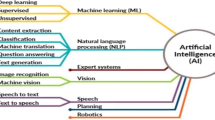Abstract
Intelligent space is space where we can easily interact with computers and robots, and get useful services from them. In such space, life can be more comfortable and more satisfying. In this article, the technologies to achieve intelligent space are introduced, and problems in using these technologies are discussed. Existing research related to intelligent space is introduced and some arguments about the future of intelligent space are presented.
Similar content being viewed by others
References
Hashimoto H (1997) Intelligent space (in Japanese). Proceedings of 36th SICE'97 103C-8, pp 45–46
Hashimoto H, Kobayashi N, Yamaguchi T (1998) Intelligent interactive space (in Japanese). Robotics and Mechatronics, 2B14, Japan Society of Mechanical Engineering
www.mems-exchange.org. “MEMS Exchange”
Inasaka R (2000) Wearable computer (in Japanese). J Virtual Reality Soc Jpn 5:13–16
www.ubiq.com/hypertexr/weiser/UbiHome.html, “Ubiquitous Computing”
www.omg.org
Goldberg K, Siegwart R (2001) Beyond Webcams: an introduction to online robots. MIT Press, Cambridge
Takamori T (1997) What is claimed to the actuators in robotics, now hoping for the new actuator (in Japanese). J Robotics Soc Jpn 15:314–317
Ando N, Korondi P, Hashimoto H (2001) Development of Micromanipulater and Haptic Interface for Networked Micromanipulation, IEEE/ASME Transactions on Mechatronics, Vol. 6, No. 4, pp. 417–427
Sugawara K (1998) Artificial intelligence (in Japanese). Morikita Shuppan, Tokyo
Brumitt B, Meyers B, Krumm J, et al. (2000) Easy Living: technologies for intelligent environments. Proceedings of the International Conference on Handheld and Ubiquitous Computing, September 2000
Coen MH. A prototype intelligent environment. www.ai.mit. edu/projects/hci.
http://oxygen.lcs.mit.edu
http://graphics.stanford.edu/projects/iwork
Sato T, Nishida Y, Mizoguchi H (1996) Robotic room: symbiosis with human through behaviour media. Robot Auton Syst 18: 185–194
www-bsac.eecs.berkeley.edu/∼pister/SmartDust
Hashimoto H (1999) Development of intelligent mechatronics (in Japanese). J Jpn Soc Technol Plasticity 40:18–24
Lee J-H Hashimoto H (2002) Intelligent Space-concept and contents. Advanced Robotics, Vol. 16, No. 3, pp. 265–280
Appenzeller G, Lee J-H, Hashimoto H (1997) Building topological maps by looking at people: an example of cooperation between intelligent space and robots, IEEE/RSJ International Conference on Intelligent Robots and Systems (IROS'97) pp. 1326–1333
Lee J-H, Hashimoto H (2003) Controlling mobile robots in distributed intelligent sensor network. IEEE Transactions on Industrial Electronics, Vol. 50, No. 5, pp. 890–902
Author information
Authors and Affiliations
Corresponding author
About this article
Cite this article
Hashimoto, H. Intelligent space: Interaction and intelligence. Artif Life Robotics 7, 79–85 (2003). https://doi.org/10.1007/BF02481152
Received:
Accepted:
Issue Date:
DOI: https://doi.org/10.1007/BF02481152




